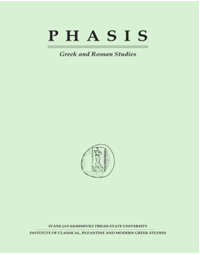On the Structure of Apologetic Works
Abstract
The encounter of Greek culture and Christian faith was the most significant phenomenon at the beginning of the Christian era. The main aspects of apologetics – defense, polemics, propaganda – were not strange for either Hellenic or Judaic traditions. Indeed, some common themes can be singled out, of which three are the most important: anti-polytheistic and anti-idolatrous polemics – in respond to the accusation of atheism; rendition and praise of Christian moral and critique of pagan customs and traditions – in respond to incest and hatred towards mankind; in respond to the accusation of novelty – call for examples from antiquity. The responses of the apologists or the first Christian intellectuals to these accusations determine the structure, genre peculiarities, language, vocabulary, style and intonation of apologetic texts. The dialogue develops Christian theology and at the same time forms a new literary genre. It is logical to consider as classical apologetic texts (classics of the genre) those works (and authors) where the following structural model is preserved: Addressees (to sovereigns, pagan society, the Jews); Criticism of paganism (anti-polytheistic and anti-idolatrous polemics;) Jewish faith; Transference of the Christian faith.


